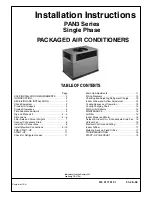
9
NOTE
: The design and installation of the duct system must
be in accordance with the standards of the NFPA for
installation of nonresidence--type air conditioning and
ventilating systems, NFPA 90A or residence--type, NFPA
90B; and/or local codes and ordinances.
FIGURE 7
Supply and Return Duct Opening
SUPPLY
DUCT
OPENING
RETURN
DUCT
OPENING
VENT HOOD
SHIPPING
LOCATION
FIGURE 8
Vertical Duct Cover Removed
DUCT COVERS REMOVED
Adhere to the following criteria when selecting, sizing, and
installing the duct system:
1. Units are shipped for horizontal duct installation (by
removing duct covers).
2. Select and size ductwork, supply--air registers, and
return--air grilles according to American Society of
Heating, Refrigeration and Air Conditioning Engineers
(ASHRAE) recommendations.
3. Use flexible transition between rigid ductwork and unit
to prevent transmission of vibration. The transition may
be screwed or bolted to duct flanges. Use suitable
gaskets to ensure weather--tight and airtight seal.
4. All units must have field--supplied filters or accessory
filter rack installed in the return--air side of the unit.
Recommended sizes for filters are shown in Table 1.
5. Size all ductwork for maximum required airflow (either
heating or cooling) for unit being installed. Avoid abrupt
duct size increases or decreases or performance may
be affected.
6. Adequately insulate and weatherproof all ductwork
located outdoors. Insulate ducts passing through
unconditioned space, and use vapor barrier in
accordance with latest issue of Sheet Metal and Air
Conditioning
Contractors
National
Association
(SMACNA) and Air Conditioning Contractors of
America (ACCA) minimum installation standards for
heating and air conditioning systems. Secure all ducts
to building structure.
7. Flash, weatherproof, and vibration isolate all openings
in building structure in accordance with local codes and
good building practices.
Step 8—Install Electrical Connections
ELECTRICAL SHOCK HAZARD
Failure to follow this warning could result in personal
injury or death.
The unit cabinet must have an uninterrupted, unbroken
electrical ground. This ground may consist of an
electrical wire connected to the unit ground screw in the
control compartment, or conduit approved for electrical
ground when installed in accordance with NEC,
ANSI/NFPA
American
National
Standards
Institute/National Fire Protection Association (latest
edition) (in Canada, Canadian Electrical Code CSA
C22.1) and local electrical codes.
!
WARNING
UNIT COMPONENT DAMAGE HAZARD
Failure to follow this caution may result in damage to the
unit being installed.
1. Make all electrical connections in accordance with
NEC ANSI/NFPA (latest edition) and local electrical
codes governing such wiring. In Canada, all
electrical connections must be in accordance with
CSA standard C22.1 Canadian Electrical Code Part
1 and applicable local codes. Refer to unit wiring
diagram.
2. Use only copper conductor for connections between
field--supplied electrical disconnect switch and unit.
DO NOT USE ALUMINUM WIRE.
3. Be sure that high--voltage power to unit is within
operating voltage range indicated on unit rating
plate.
4. Do not damage internal components when drilling
through any panel to mount electrical hardware,
conduit, etc.
!
CAUTION
HIGH--VOLTAGE CONNECTIONS
ELECTRICAL SHOCK HAZARD
Failure to follow this warning could result in personal
injury or death.
Before making any wiring changes,
make sure
the gas
supply is switched off first.
Then
switch off the power
supply to the unit and install lockout tag.
!
WARNING



















